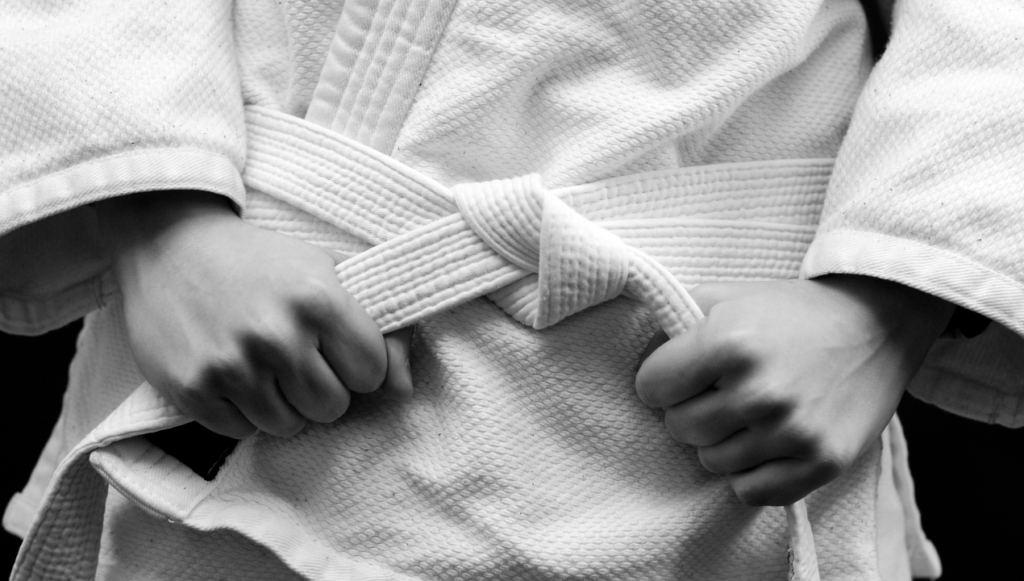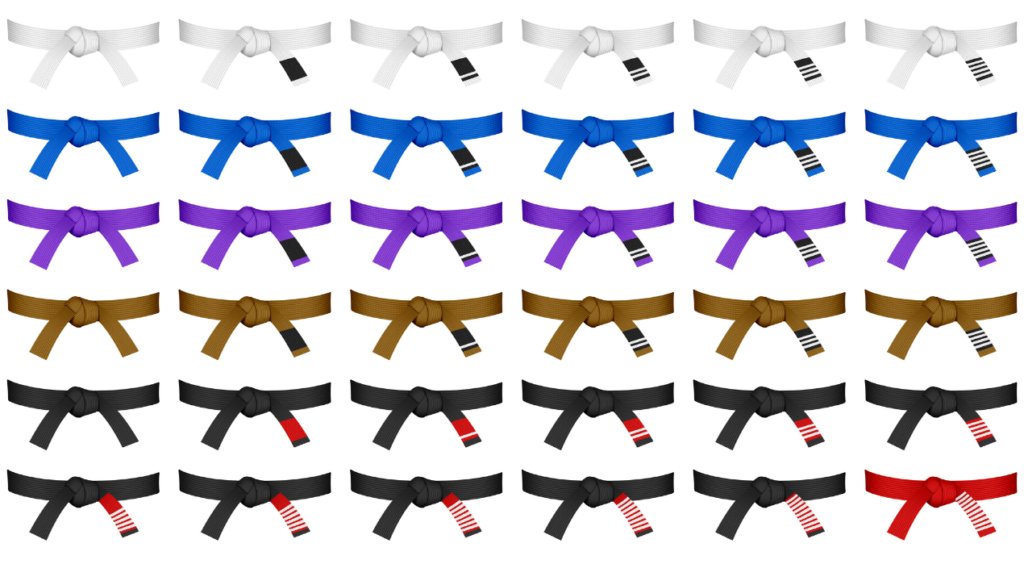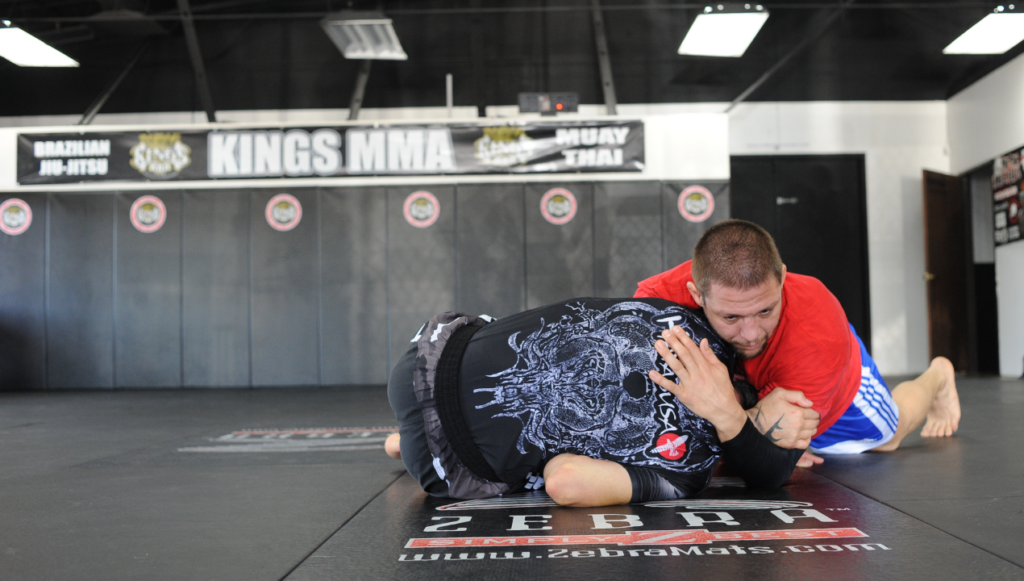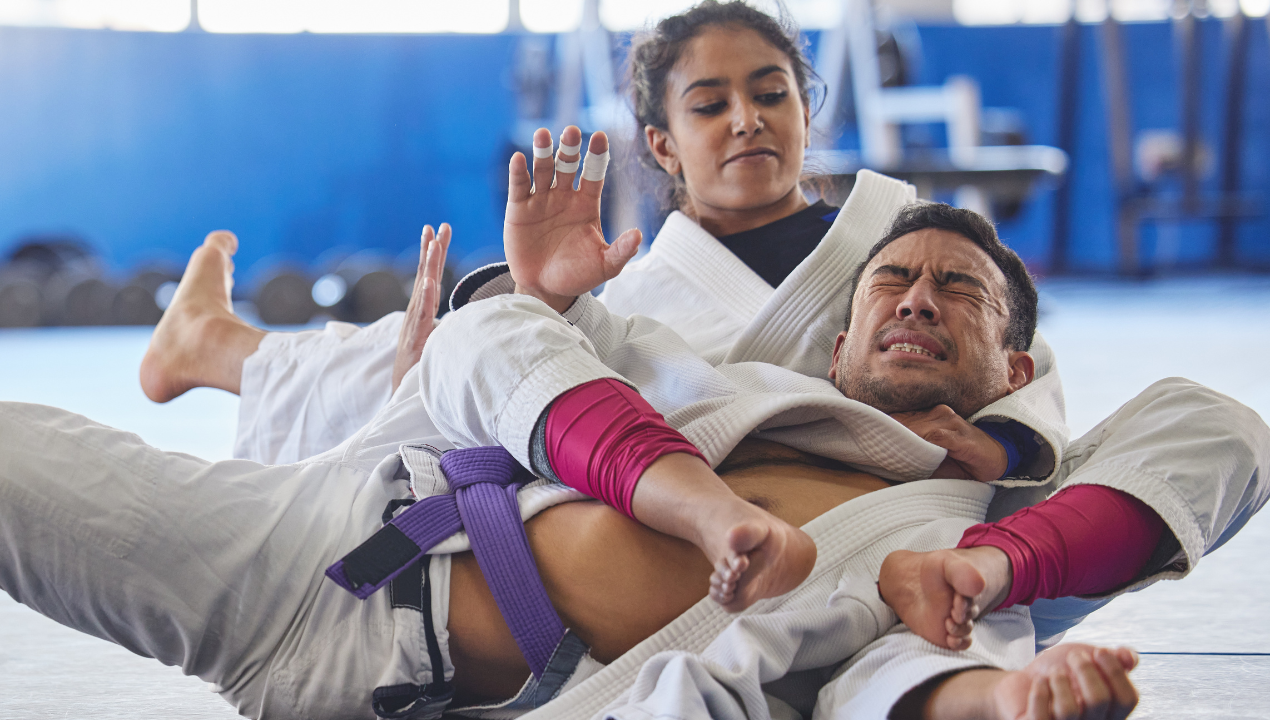If you have even a passing interest in Brazilian Jiu Jitsu (BJJ), you have probably heard of white belts and black belts. But what happens in between? Keep reading to learn more about the BJJ belt system for adults and kids, how it works in no-gi, and more.
BJJ Belt System & Progression (Rankings for Adults)
Different schools may vary slightly in their requirements for progressing through the levels of BJJ. But all belt ranking systems recognize five belt color levels. given in the following order: white, blue, purple, brown, and black.
Most traditional schools adhere to rules set by the International Brazilian Jiu-Jitsu Federation (IBJJF).
Coaches generally take into account a few different factors when deciding to promote Brazilian Jiu-Jitsu students, including:
- Hours of mat time
- Length of time at the current level
- Appropriate knowledge of techniques – skill level
- Dedication to the sport, school, and teammates
Many coaches also use personal discretion to assess whether a student is mentally and physically ready for the next level. And some schools may incorporate a belt test before promoting an adult rank.
Every BJJ practitioner’s journey is unique, but the following are some general descriptions of what you can expect at each level.

White belt – Beginning Foundation
- IBJJF minimum time to progress: No minimum
- Average total years of training: 0-2 years
Because there is no prerequisite for receiving your white belt in jiu-jitsu, your school will provide you with one on your first day of training. White belt students focus on learning the terminology of jiu jitsu and practicing fundamental positions and basic BJJ moves, such as:
- Guard
- Mount
- Side control
- Back control
- Hip Escape
- Bridge, and
- Breakfall
Physically, white belt-level practitioners increase their endurance, strength, and flexibility while adjusting to the feel of grappling.
Major Goal: Learning to relax and stay focused while in uncomfortable situations and bad positions.
Blue belt – Increasing Technical Knowledge
- IBJJF minimum time to progress: 2 years
- Average total years of training: 2-3 years
The blue belt level builds on the foundation developed at white belt through the practical application of basic techniques in drilling and sparring.
Most practitioners at the blue belt stage focus on increasing technical proficiency in foundational and defensive moves.
Like anticipating and responding to their opponent’s movements and escaping submission attempts.
Major Goal: Establish a solid defense, including escapes from all positions.
Purple belt – Your Individual Game
- IBJJF minimum time to progress: 1.5 years
- Average total years of training: 4-5 years
At this stage, the BJJ student has amassed hundreds of hours on the mat and has well-rounded skills in most techniques and submissions.
The purple belt level practitioner is a great time to explore the parts of jiu jitsu that work best for you personally. You’ll start chaining different offensive moves into sequences, especially when working with lower-ranked students.
Major Goal: Develop your unique BJJ game using techniques and submissions that work best with your body type, level of athleticism, and physical fitness.
Brown belt – Strategy and Precision
- IBJJF minimum time to progress: 1 year
- Average total years of training: 7-8 years
After several years of dedicated training in BJJ, the brown belt has a wide breadth of knowledge of all the fundamental techniques, submissions, and positions and has a fully developed individual game.
This level is where the BJJ practitioner hones the mental aspects of his or her game: focusing on strategy, laying traps for opponents, and finding ways to guide opponents into weaker positions.
Major Goal: Discover and strengthen any weak points in your game, and learn to think strategically.
Black belt – Mastering Fundamentals
- IBJJF minimum time to progress: 3 years
- Average total years of training: 10-11 years
Rather than viewing the black belt level as the ultimate goal of the BJJ journey, most BJJ practitioners talk about this level as a new beginning.
Having attained an expert level of skill in the physical, technical, and mental aspects of jiu jitsu, the black belt practitioner continues to fine-tune all of these areas but also finds fulfillment in passing on knowledge of advanced techniques to students, even if not as an official instructor.
Major Goal: Seek a deeper understanding of the art and philosophy of jiu jitsu and increase the efficiency of established skills.
What is the Stripe System?

Stripes on a BJJ student’s belt represent that student’s level at a given belt. More stripes usually denote more proficiency and how close the student is to receive the next belt.
Each BJJ school has its own requirements and timeline for awarding stripes.
How long does it take to get belts in BJJ?
Given that there are only five belt levels in BJJ, you can expect to spend a significant amount of time before moving on to the next belt.
How long it takes for you to attain each belt will depend on a lot of different factors, including, but not limited to:
- Your individual school and coaches’ approach
- How often you train
- Whether or not you compete
- Your athleticism, skill, and physical fitness
- Previous experience in wrestling or other martial arts like judo
At a minimum, BJJ students spend a year or two at each level, but it is not unusual for belt promotions to take longer than that, especially if the student is training as a hobby, not a career.
It generally takes around 10 years of consistent training full-time to get your black belt.
Can you get a black belt in BJJ in 3 years?
Although a few exceptional athletes earned their BJJ black belts in 3 years or less, the process takes much longer for the average person.
The most notable examples of quicker-than-normal promotions to black belt status include:
- Caio Terra, whose promotion to black belt in 3 years remains one of the fastest in BJJ history.
- BJ Penn earned his nickname “The Prodigy” by living at the gym and exclusively training for 3 years to earn his black belt.
- Travis Stevens, who was already an Olympian in Judo, took only 18 months to earn his black belt.
What Comes After Black Belt?
Once an experienced practitioner has earned a black belt, there are further degrees, also known as dans, of black belt they can receive if they continue to train actively.
What does a “Dan” or a “degree” mean in BJJ?
In martial arts, the term “dan” usually refers to the rank of a practitioner who has moved beyond the basic ranks.
Brazilian jiu jitsu black belts who continue to learn actively, train, and participate in the sport earn degrees that denote how long they have been training.
How many degrees are there of BJJ black belt?
There are 10 degrees of BJJ black belt. Once someone has reached the sixth degree of black belt plus an additional seven years of training, he or she is eligible to become a seventh-degree black belt and earn an alternating red and black belt, which is also called a coral belt because of its color scheme that resembles a coral snake.
Red and white belts (also called coral belts) are 8th-degree black belts, also known as “masters.” Brazilian jiu jitsu black belts of the 9th or 10th degree receive a red belt and are referred to as “grand master.”
How Many Grand Masters Have There Been?
Although there is some discrepancy among various sources, according to Eastern Europe BJJ, there have been fifty 9th-degree and five 10th-degree black belts.
How is the BJJ Belt Ranking & Progression Different for Kids?
Generally speaking, kids advance through the BJJ belt ranks much more quickly than adults.
There are more youth belts than adult belts to accommodate this quicker belt progression and to allow kids to feel more accomplishment as they move up.
For children under the age of 16, the IBJJF suggests a monthly, triannual, or quarterly graduation system. Coloured belts for kids from lowest to highest are:
- White belt
- Gray-and-white belt
- Solid Grey belt
- Gray-and-black belt
- Yellow-and white belt
- Solid Yellow belt
- Yellow-and-black belt
- Orange-and-white belt
- Solid Orange belt
- Orange-and-black belt
- Green-and-white belt
- Solid Green belt
- Green-and-black belt
Is No-Gi BJJ Ranking Different?

Many BJJ athletes choose to train both in the gi and in no-gi and are generally awarded belts following the same system outlined above.
For gyms and practitioners specializing in no-gi, there is some debate in the BJJ community about whether someone who trains no-gi exclusively should be considered the same rank as someone of equal skill and time training who trains gi.
Although some no-gi schools award colored shorts or rash guards to denote rank, many do not. As no-gi continues to grow in popularity, attitudes from more traditional schools about the legitimacy of no-gi ranking might shift.
Who Can Give Belt Promotions?
Qualified instructors can give belt or stripe promotions to lower-ranked students.
For instance, if a jiu jitsu instructor is a brown belt, he can promote students up to the level of purple belt. But only black belt instructors can give a brown belt to a purple belt.
Who Are The Best BJJ Practitioners in UFC?
Most fighters in the UFC are mixed martial artists, so they don’t focus on only one discipline.
However, there have been some UFC fighters best known for their BJJ skills, including:
- Royce Gracie
- Rickson Gracie
- BJ Penn
- Demian Maia
- Nate Diaz
- Ronaldo Souza
- Mackenzie Dern
- Charles Oliveira
BJJ Belt System in Conclusion
Whether you train jiu jitsu, have a child who trains, or are just interested in the sport, the Brazilian jiu jitsu belt system can be confusing at first.
Hopefully, you’ve found some helpful information here. If you train, remember that the belt is not the goal.
Jiu jitsu is a journey worth taking whether you ever become a black belt. But you may want to check out our guide to Judo vs Brazilian Jiu Jitsu to see which is best for you.
